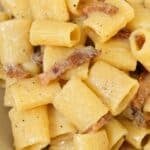Pasta alla Gricia - Authentic! (VIDEO)
Servings: 4
Ingredients
- 10 oz guanciale
- 1/2 tablespoon kosher salt
- 1 teaspoon freshly ground black pepper
- 16 ounces uncooked pasta (mezzi rigatoni, rigatoni, thick spaghetti or bucatini)
- 4 ounces Pecorino Romano finely grated
Instructions
- Remove the tough outer rind from the guanciale. Slice the guanciale into ½ inch thick slabs, then into thin strips.
- Bring a pot of boiling water (5 quarts) to a boil. Add the kosher salt and add the pasta of choice. Cook until al dente. Keep the pasta water hot over low heat after transferring the pasta in step 4.
- As soon as the pasta is cooking, to a dry nonstick pan, add the guanciale. Turn the heat to medium high and cook the guanciale for 5-6 minutes until the guanciale is a deep golden brown and crispy and the fat has rendered. Use paper towels to drain excess guanciale fat leaving about 3/4 cup. Turn off the heat and add a ladle full of pasta water to the pan to stop the guanciale from cooking further.
- Add the strained pasta directly to the pan along with the pepper. Mix until well coated. Transfer everything to a large metal mixing bowl and place it over the steaming pasta water that's over low heat.
- Add the pecorino cheese a few handfuls at a time, mixing and tossing so that the cheese emulsifies with the pasta water and guanciale fat. Mix, then continue adding 1/2 ladle full of pasta water at a time and mix to loosen the sauce. The result should be a creamy, emulsified sauce. Serve on a warm plate and enjoy.
Notes
Key Tips:
Ensure that your pecorino romano is finely grated. This will allow it to melt quickly and you'll have an easier time emulsifying it into the sauce.
Be aware of how much salt you use in the pasta water: In this case, you do not want your pasta water extremely salty because it is essential for emulsifying the sauce. This is why I only use ½ tablespoon of kosher salt for every 5 quarts of water, just enough to season the pasta. Since the pecorino and guanciale brings a lot of salt to the dish, you do not want to add pasta water that is too salty. You can always add salt if needed, but you can't take it out!
If the sauce is too thick: Add more pasta water to loosen the sauce, but ensure that the water is not boiling, otherwise it will cause the cheese to clump. The temperature of the water should be around 130-140F before coming in contact with the cheese. This is my top tip to ensure the cheese does not clump.
If the sauce is too thin (you added too much pasta water): simply add more grated pecorino romano cheese to thicken up the sauce. Be aware that the sauce will also thicken overtime as it sits.
Serving tip: Serve the pasta in a hot bowl to prevent the sauce from congealing quickly! I use a restaurant trick of adding hot pasta water to the bowl to warm it up, then dump it out just before I plate it with the pasta.
Nutrition
Calories: 589kcal | Carbohydrates: 1g | Protein: 14g | Fat: 59g | Saturated Fat: 24g | Polyunsaturated Fat: 0.1g | Monounsaturated Fat: 2g | Cholesterol: 98mg | Sodium: 863mg | Potassium: 18mg | Sugar: 0.2g | Vitamin A: 88IU | Calcium: 226mg | Iron: 0.2mg
